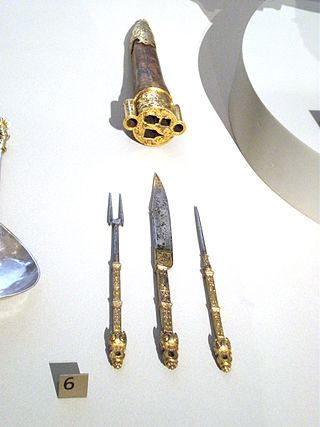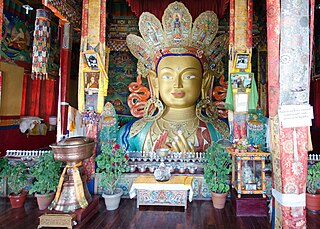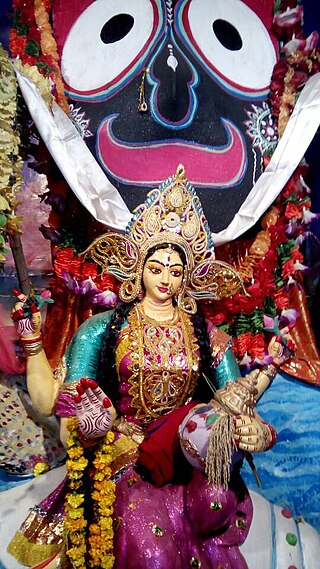
A spoon is a utensil consisting of a shallow bowl, oval or round, at the end of a handle. A type of cutlery, especially as part of a place setting, it is used primarily for transferring food to the mouth. Spoons are also used in food preparation to measure, mix, stir and toss ingredients and for serving food. Present day spoons are made from metal, wood, porcelain or plastic. There are a wide variety of spoons that are made of a variety of materials and by different cultures for many different uses and foods.

Cutlery, includes any hand implement used in preparing, serving, and especially eating food in Western culture. A person who makes or sells cutlery is called a cutler. The city of Sheffield in England has been famous for the production of cutlery since the 17th century and a train – the Master Cutler – running from Sheffield to London was named after the industry. Bringing affordable cutlery to the masses, stainless steel was developed in Sheffield in the early 20th century.

The vast majority of surviving Tibetan art created before the mid-20th century is religious, with the main forms being thangka, paintings on cloth, mostly in a technique described as gouache or distemper, Tibetan Buddhist wall paintings, and small statues in bronze, or large ones in clay, stucco or wood. They were commissioned by religious establishments or by pious individuals for use within the practice of Tibetan Buddhism and were manufactured in large workshops by monks and lay artists, who are mostly unknown. Various types of religious objects, such as the phurba or ritual dagger, are finely made and lavishly decorated. Secular objects, in particular jewellery and textiles, were also made, with Chinese influences strong in the latter.

The Mildenhall Treasure is a large hoard of 34 masterpieces of Roman silver tableware from the fourth century AD, and by far the most valuable Roman objects artistically and by weight of bullion in Britain. It was found at West Row, near Mildenhall, Suffolk, in 1942. It consists of over thirty items and includes the Great Dish which weighs over 8 kg (18 lb).
CBKT-DT is a CBC Television station in Regina, Saskatchewan, Canada. It is part of a twinstick with Ici Radio-Canada Télé station CBKFT-DT. The two outlets share studios with sister radio stations CBK, CBK-FM and CBKF-FM at the CBC Regina Broadcast Centre at 2440 Broad Street in Downtown Regina; CBKT-DT's transmitter is located near McDonald Street/Highway 46, just northeast of Regina proper.

Tableware items are the dishware and utensils used for setting a table, serving food, and dining. The term includes cutlery, glassware, serving dishes, serving utensils, and other items used for practical as well as decorative purposes. The quality, nature, variety and number of objects varies according to culture, religion, number of diners, cuisine and occasion. For example, Middle Eastern, Indian or Polynesian food culture and cuisine sometimes limits tableware to serving dishes, using bread or leaves as individual plates, and not infrequently without use of cutlery. Special occasions are usually reflected in higher quality tableware.

Ulanqab or Ulan Chab is a region administered as a prefecture-level city in south-central Inner Mongolia, China. Its administrative centre is in Jining District, which was formerly a county-level city. It was established as a prefecture-level city on 1 December 2003, formed from the former Ulanqab League. The Ulanqab Stadium is located in the city.

A pizza cutter is a handheld kitchen utensil that is used to cut various items into sections or slices. Due to its prevalence in the making of pizza, it has earned the name "pizza cutter." The typical pizza cutter has a wheel-shaped blade that is attached to a handle. The original design has been modified over the years to include different sizes, blades, handles, and uses. The typical pizza cutter is not limited to cutting pizza but also for a variety of other tasks such as cutting dough or chopping herbs.
CHAB is a radio station in Moose Jaw, Saskatchewan. Owned by Golden West Broadcasting, it broadcasts a classic hits format serving Moose Jaw and the surrounding area.

Tea utensils are the tools and utensils used in chadō, the art of Japanese tea.

A pastry blender, or pastry cutter, is a cooking utensil used to mix a hard (solid) fat into flour in order to make pastries. The tool is usually made of narrow metal strips or wires attached to a handle, and is used by pressing down on the items to be mixed. It is also used to break these fats into smaller pieces. The blending of fat into flour at this stage impacts the amount of water that will be needed to bind the pastry into a dough.

A ladle is a large, deep spoon, often used in the preparation and serving of soup, stew, or other foods.
CHAB-TV was a television station in Moose Jaw, Saskatchewan, Canada.

A kitchen utensil is a small hand-held tool used for food preparation. Common kitchen tasks include cutting food items to size, heating food on an open fire or on a stove, baking, grinding, mixing, blending, and measuring; different utensils are made for each task. A general purpose utensil such as a chef's knife may be used for a variety of foods; other kitchen utensils are highly specialized and may be used only in connection with preparation of a particular type of food, such as an egg separator or an apple corer. Some specialized utensils are used when an operation is to be repeated many times, or when the cook has limited dexterity or mobility. The number of utensils in a household kitchen varies with time and the style of cooking.

Lakshmi Puja is a Hindu occasion for the veneration of Lakshmi, the goddess of prosperity and the supreme goddess of Vaishnavism. The occasion is celebrated on the amavasya in the Vikram Samvat Hindu calendar month of Ashwayuja or Kartika, on the third day of Deepavali (Tihar) in most part of India and Nepal. In Assam, Bengal, and Odisha, this puja is celebrated five days after Vijaya Dashami.

Asnoun is a small village in the Zgharta District, in the North Governorate of Lebanon. It is located 2 km south of the town of Zgharta.
Amasya Museum, also known as Archaeological Museum of Amasya, is a national museum in Amasya, northern Turkey, exhibiting archaeological artifacts found in and around the city as well as ethnographic items related to the region's history of cultural life. Established in 1958, the museum owns nearly twenty-four thousand items for exhibition belonging to eleven historic civilizations.

Pichangatti is a broad-bladed knife of the Kodavas of Karnataka, India. The characteristic of the pichangatti is its silver hilt with bulbous-shaped pommel in the shape of a parrot's head. The pichangatti features in the traditional male dress of the Kodavas.

Combination eating utensils, also known as hybrid utensils, are utensils that have the qualities of other utensils combined into one. This can be done to make a more convenient, less wasteful, or more cost-efficient product. Many different types of combination utensils have been created, each designed to serve a different purpose.















